
PUMPA - SMART LEARNING
எங்கள் ஆசிரியர்களுடன் 1-ஆன்-1 ஆலோசனை நேரத்தைப் பெறுங்கள். டாப்பர் ஆவதற்கு நாங்கள் பயிற்சி அளிப்போம்
Book Free DemoStages of meiosis:
- In \(1905\), Farmer coined the term meiosis.
- Meiosis is a type of cell division that produces gametes or sex cells.
- There is a specialised diploid (\(2n\)) cells that undergo reductional division, results in the formation of haploid (\(n\)) gametes, i.e., the chromosome number is reduced to haploid (\(n\)) from diploid (\(2n\)).
The process of meiosis happens in two stages, i.e.
- Heterotypic division or meiosis - I
- Homotypic division or meiosis - II
1. Meiosis I:
In meiosis -I, the germ cells divide into two daughter cells with only half the number of chromosomes compared to mother germ cells. Chromosome number is different from the parent cell.
2. Meiosis II:
In contrast to meiosis -I, Meiosis -II resembles a normal mitosis. At the end of meiosis -II, four haploid cells will be formed.
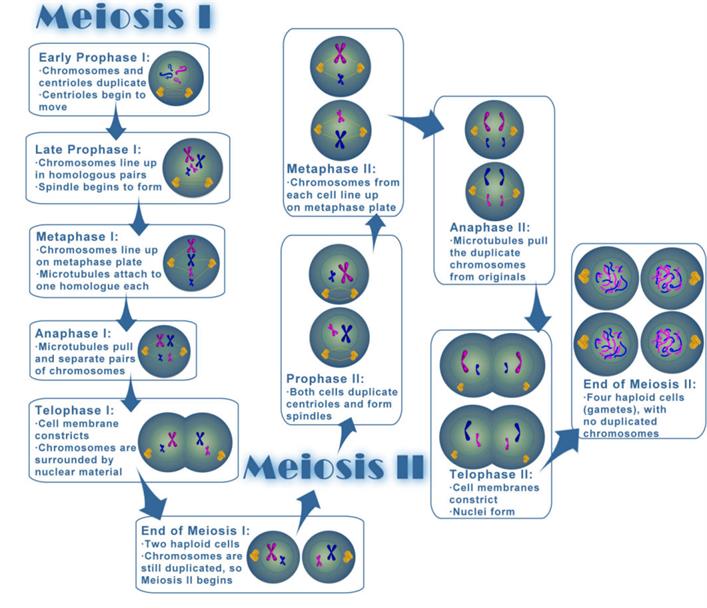
Meiosis
Stages of meiosis I:
This division begins after the interphase of the cell cycle. The following are the stages of meiosis I,
1. Prophase I
2. Metaphase I
3. Anaphase I
4. Telophase I
5. Cytokinesis I
2. Metaphase I
3. Anaphase I
4. Telophase I
5. Cytokinesis I
1. Prophase I:
It is the first meiotic division. This stage takes a longer duration and is more complicated than the prophase of mitosis.
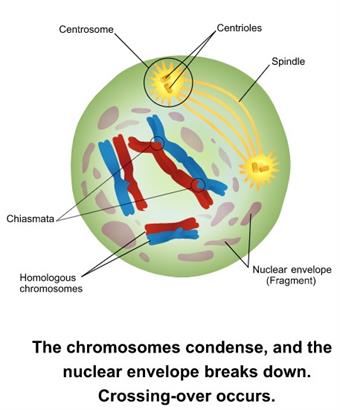
Prophase I
It is further divided into the following five stages.
- Leptotene
- Zygotene
- Pachytene
- Diplotene
- Diakinesis
a. Leptotene:
- The chromosomes become uncoiled and gradually visible.
- Inside the nucleus, chromosomes appear as long, beaded thread-like structures and take up a specific orientation directed towards the centrioles. This arrangement makes the group of chromosomes in the nucleus seems like a bouquet. Hence this stage is called a bouquet stage.
b. Zygotene:
The word zygon means 'adjoining'.
During this stage, two homologous chromosomes approach each other and start to pair. This association of chromosomes is called synapsis.
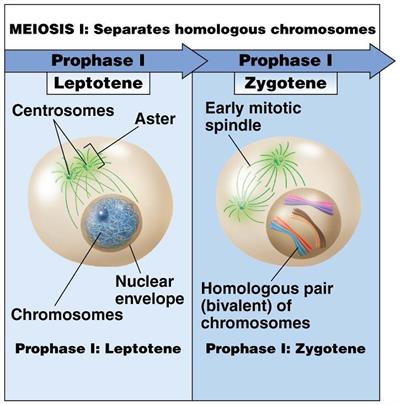
c. Pachytene:
The word 'pachus' means 'thick')
- In this stage, the long, thick, short, paired twisted thread-like chromosomes are visible.
- The paired chromosomes are called bivalents.
- Each bivalent consist of four chromatids. Hence it is called a tetrad stage.
- The pair of homologous chromosomes start to separate.
- Some of the portions remain attached at one or more points by X-shaped arrangements known as chiasmata.
- The attached segments of chromatids will break at the attached points and got interchanged. As a result, genetic recombination occurs.
- This phenomenon of exchange of genetic material (\(DNA\)) between two homologous chromosomes is called crossing over.
d. Diplotene:
- In this stage, bivalent homologous chromosomes divide longitudinally into two identical chromatids.
- The homologous chromosomes repel each other and separate except at the sites of crossing over.
- The X-shaped structure chiasmata begins to move along the chromosome's length from the centromere towards the end, which results in terminalisation.
e. Diakinesis:
- The final stage of meiotic prophase I is diakinesis.
- During this stage, the paired chromosomes are shortened and thickened the nuclear membrane and nucleolus disappear.
- Spindle fibres are assembled to prepare the homologous chromosome for separation.
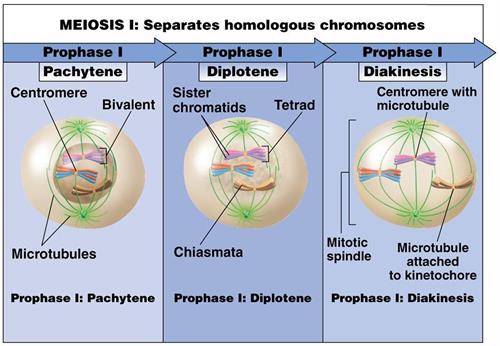
2. Metaphase I:
- During this stage, the bivalent chromosomes align on the equatorial plate or metaphase plate.
- The microtubules from the opposite poles of the spindle attach to the pair of homologous chromosomes.
- Each chromosome consists of two chromatids that do not separate as in mitosis. The centromere also does not divide.
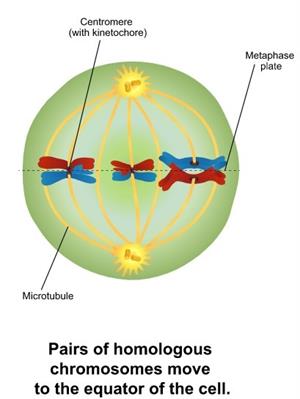
Metaphase I
3. Anaphase I:
The homologous chromosome with its two chromatids and undivided centromere move towards the cell's opposite poles. This stage of the chromosome is called the diad of cells.
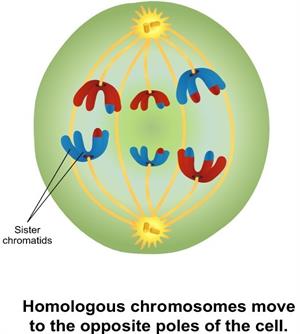
Anaphase I
4. Telophase I:
- A haploid number of chromosomes get uncoiled and elongated once it reaches their respective poles.
- Reappearance of the nuclear membrane and nucleolus will occur, which results in the formation of two daughter nuclei.
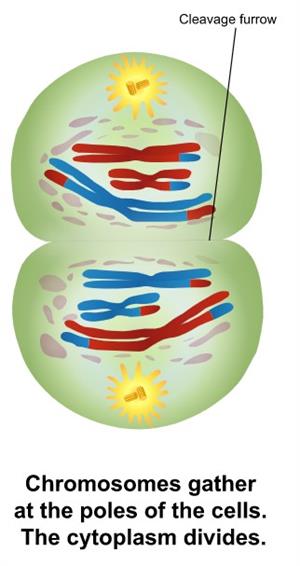
Telophase I and cytokinesis
5. Cytokinesis:
Reference:
https://upload.wikimedia.org/wikipedia/commons/7/75/Meiosis.jpg
https://www.flickr.com/photos/94415613@N08/9882032505/in/photostream/
https://www.flickr.com/photos/94415613@N08/9882262713
https://upload.wikimedia.org/wikipedia/commons/7/74/Meiosis_Stages.svg